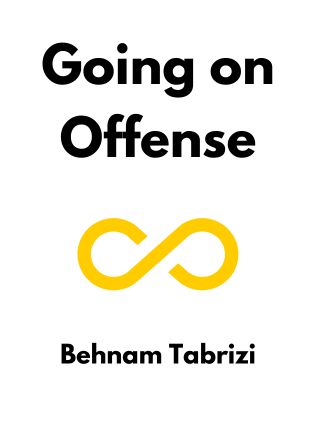
Going on Offense
A Leader's Playbook for Perpetual Innovation
By Behnam Tabrizi
Published 08/2023
About the Author
Behnam Tabrizi is a renowned expert in the field of organizational transformation and innovation. He has spent over 25 years researching and advising on how to drive sustained change in large organizations. Tabrizi is a consulting professor at Stanford University and has authored several influential books. His work emphasizes practical, actionable strategies that leaders at all levels can use to foster a culture of perpetual innovation. His insights are drawn from extensive research and real-world case studies of leading companies that have successfully navigated the complexities of rapid technological advancement and market disruption.
Main Idea
The central premise of "Going on Offense: A Leader’s Playbook for Perpetual Innovation" is that in today’s fast-paced, technology-driven world, organizations must adopt a mindset of continuous innovation to remain competitive. Tabrizi argues that large companies often become complacent and lose their innovative edge. He provides a comprehensive guide on how to instill a culture of agility, experimentation, and customer obsession throughout the organization. This book outlines a holistic approach to transforming companies into perpetual innovators by fostering generosity, ferocity, and courage at all levels.
Table of Contents
- Introduction
- Seeing the Challenge
- Part One: Generous
- Part Two: Ferocious
- Part Three: Courageous
- Conclusion
Introduction
In the introduction, Tabrizi sets the stage by highlighting the need for perpetual innovation in the face of rapid technological changes and market disruptions. He explains that traditional companies often fall into the trap of complacency, focusing on operational efficiency at the expense of innovation. The introduction emphasizes the importance of adopting a proactive, offensive strategy to stay ahead of the competition.
Seeing the Challenge
Many leaders view the transformation of large organizations into perpetually innovative entities as a daunting task. Tabrizi points out that even once-nimble tech giants like Facebook and Google have struggled to maintain their innovative spirit. He uses the example of Nokia, which failed to adapt to the changing market landscape due to its focus on operational metrics and lack of cultural transformation.
The key to overcoming these challenges lies in cultivating an agile mindset that prioritizes reimagining and implementing new processes, products, and services. This requires a shift from a bureaucratic, command-and-control structure to one that encourages experimentation and adaptability.
Part One: Generous
Setting an Existential Purpose
Tabrizi emphasizes that perpetual innovation requires a deep-seated existential purpose. He illustrates this with the example of Microsoft under Satya Nadella’s leadership. Nadella revived Microsoft by rediscovering its core purpose and aligning it with the personal values of its employees. This existential commitment goes beyond superficial corporate strategies, embedding a sense of higher purpose that motivates employees to innovate continuously.
Sign up for FREE and get access to 1,400+ books summaries.
You May Also Like
The Subtle Art of Not Giving a F*ck
A Counterintuitive Approach to Living a Good Life
By Mark MansonThe Lean Startup
How Today's Entrepreneurs Use Continuous Innovation to Create Radically Successful Businesses
By Eric RiesWho Moved My Cheese?
An Amazing Way to Deal with Change in Your Work and in Your Life
By Spencer Johnson, M.D.You Are A Badass
How to Stop Doubting Your Greatness and Start Living an Awesome Life
By Jen SinceroDaring Greatly
How the Courage to Be Vulnerable Transforms the Way We Live, Love, Parent, and Lead
By Brené Brown



















